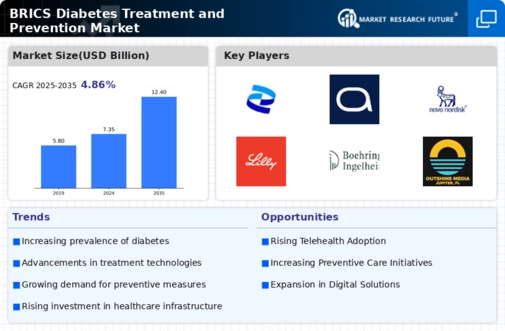The Global BRICS Diabetes Treatment and Prevention Market has gained considerable attention due to the rising prevalence of diabetes across the member countries of BRICS, which includes Brazil, Russia, India, China, and South Africa.
The market landscape is characterized by intense competition among healthcare companies striving to offer innovative treatment solutions and preventive measures for diabetes. The increasing investment in healthcare infrastructure, coupled with a growing awareness of diabetes management among patients, is driving the competition further.
Companies are focusing on research and development to create effective medications, lifestyle interventions, and technologies such as diabetes management software and devices. The rise of digital health platforms has also transformed the way care is delivered, adding another layer of competition within the market.
As the healthcare needs in these emerging economies continue to evolve, players in the diabetes treatment and prevention landscape must adapt quickly to capture market share and meet the demands of their patients.
Merck and Co has established itself as a formidable player in the Global BRICS Diabetes Treatment and Prevention Market. The company's strong portfolio of diabetes medications, particularly those aimed at managing both Type 1 and Type 2 diabetes, positions it favorably within this competitive landscape.
Merck's commitment to research and development is evident in its ongoing efforts to innovate and improve diabetes treatments, enhancing the company's reputation as a leader in the field. The firm's extensive global reach allows it to leverage its resources effectively, tapping into diverse markets while navigating regulatory landscapes with ease.
Additionally, Merck's robust collaborations with healthcare providers, advocacy groups, and academic institutions further bolster its market presence and strengthen its position as a trusted partner in diabetes care. The company's established brand recognition and unwavering focus on improving patient outcomes underpin its competitive edge in the Global BRICS arena.
Pfizer is another key contender in the Global BRICS Diabetes Treatment and Prevention Market, known for its diversified product offerings and strong market presence. The company's portfolio includes several essential medications designed to manage diabetes effectively, as well as complementary products that assist in broader patient health management.
Pfizer's commitment to innovation is demonstrated through ongoing research initiatives aimed at discovering new formulations and treatment options that address the complexities associated with diabetes.
Moreover, the company's strategic mergers and acquisitions have strengthened its capabilities in this market, allowing it to integrate new technologies and enhance its service offerings. This has not only expanded Pfizer’s reach but also solidified its competitive position in the market.
By fostering partnerships with healthcare systems and leveraging digital health solutions, Pfizer continues to adapt to the evolving landscape of diabetes care, ensuring that it remains at the forefront of treatment developments in the Global space.






















Leave a Comment